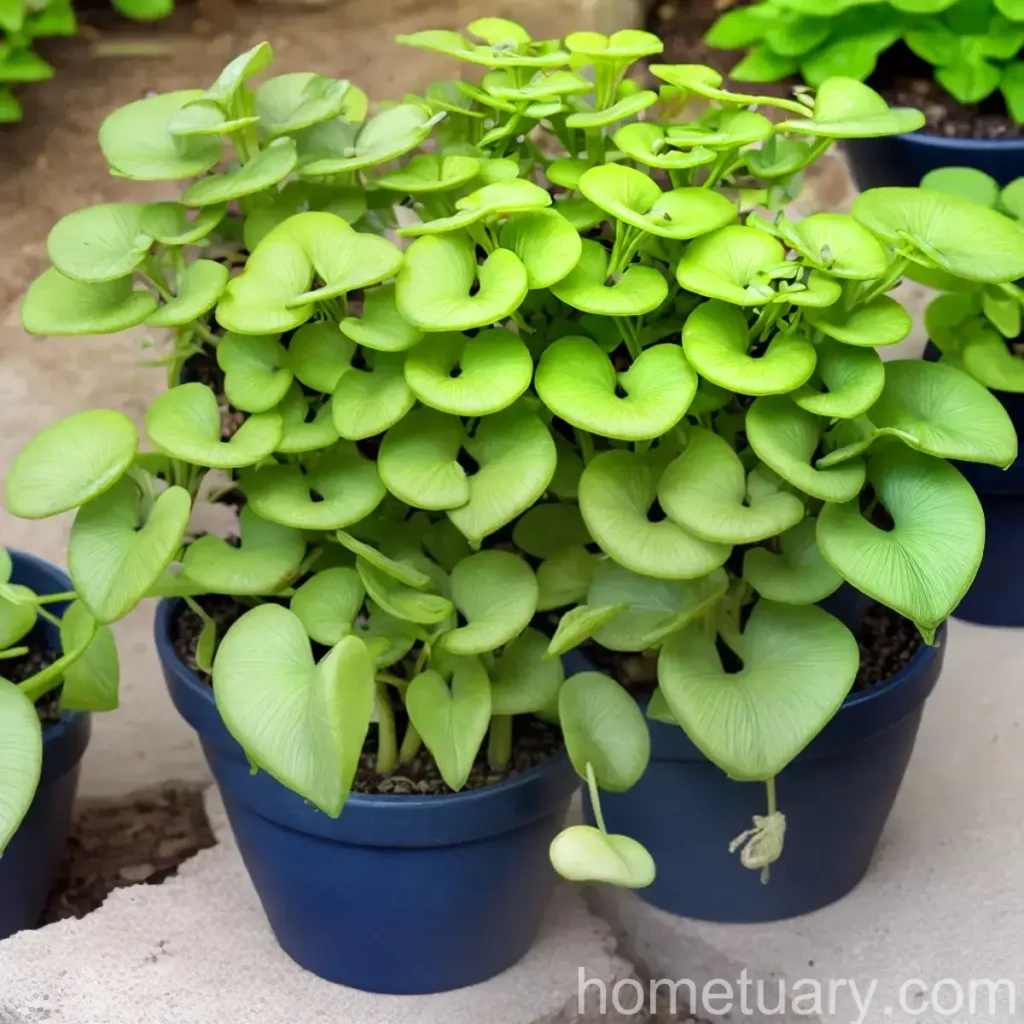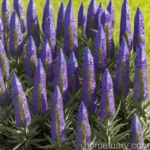The Versatile Navelwort: Omphalodes cappadocica
Plants play a pivotal role in the natural world, from providing oxygen to creating ecosystems. One such plant that holds both aesthetic and ecological value is the navelwort, scientifically known as Omphalodes cappadocica. This perennial herbaceous plant, also referred to as blue-eyed Mary or alpine forget-me-not, boasts stunning blue flowers and serves as an exemplary ground cover. In this comprehensive guide, we will delve into the nature of the navelwort plant, its cultural requirements, uses, as well as its role in horticulture and landscaping.
What is Navelwort (Omphalodes cappadocica)?
Navelwort, botanically named Omphalodes cappadocica, is a species of flowering plant native to the eastern Mediterranean, specifically the regions of Turkey and the Caucasus. Belonging to the Boraginaceae family, this perennial herbaceous plant is embraced for its delicate, slightly serrated leaves and striking clusters of sky-blue flowers. The common names “blue-eyed Mary” and “alpine forget-me-not” are attributed to its distinct appearance, evoking a sense of charm and allure.
Key Takeaways – Navelwort (Omphalodes cappadocica)
Before delving into the specifics of cultivating navelwort, let’s outline the key takeaways about this captivating plant:
- Botanical Name: Omphalodes cappadocica
- Common Names: Blue-eyed Mary, Alpine Forget-me-not
- Plant Type: Perennial Herbaceous
- Preferred Habitat: Shade-loving, Ideal for Woodland Gardens
- Flowering: Spring-blooming, Blue Flowers
- Uses: Ground Cover, Landscaping, Container Planting
- Characteristics: Attractive Foliage, Low-growing, Deer-resistant, Fragrant
Culture
Cultivating navelwort in a garden or landscape setting requires a fundamental understanding of its cultural needs. From the soil composition to pruning techniques, it’s essential to provide an environment that supports the growth and vitality of this beautiful perennial.
Water
Navelwort thrives in moist, well-drained soil. While it exhibits a degree of drought tolerance once established, consistent watering is essential, particularly during periods of dry weather. Adequate moisture levels contribute to robust foliage and prolific blooming, enhancing its ornamental appeal.
Sunlight
Being a shade-loving plant, navelwort flourishes in environments with dappled or partial shade. Excessive exposure to direct sunlight can lead to leaf scorching and diminished flowering. Thus, positioning it in areas with filtered light or partial shade is crucial for its optimal health and growth.
Fertilizer
When it comes to fertilization, a balanced, organic fertilizer applied in the early spring can promote healthy foliage and prolific flowering. However, it’s important to avoid over-fertilization, as excessive nutrients can lead to lush foliage at the expense of flower production.
Soil
Navelwort thrives in well-drained, humus-rich soil with a slightly acidic to neutral pH. Loamy soils with good moisture retention are particularly favorable for its cultivation. Adequate organic matter can further enhance the soil’s structure and fertility, supporting the plant’s overall vigor.
Pruning
Pruning requirements for navelwort are minimal, mainly limited to removing spent flowers and any dead or damaged foliage. This practice not only promotes a tidy appearance but also encourages the plant to redirect its energy towards new growth and blooming.
Uses
Navelwort exhibits versatility in its uses, ranging from ground cover plantings to ornamental container displays. Its attractive foliage and delicate blue flowers make it a desirable addition to various garden settings, contributing both aesthetic and functional value.
Ground Cover
The low-growing, spreading nature of navelwort makes it an excellent choice for ground cover plantings. Whether adorning the forest floor in a woodland garden or lining the borders of pathways, its dense, lush foliage creates a visually appealing carpet, effectively suppressing weed growth while adding a pop of color.
Landscaping
In landscaping applications, navelwort serves as a valuable component in creating visually captivating and ecologically beneficial environments. Its adaptability to shade and woodland settings makes it ideal for enhancing the understory of gardens, adding layers of texture and color to the landscape.
Container Planting
For those with limited garden space or those seeking to adorn their patios and balconies with natural beauty, navelwort can be cultivated in containers. Its cascading growth habit makes it an attractive choice for hanging baskets, window boxes, or as a filler plant in mixed container arrangements.
Propagation
Propagating navelwort can be achieved through several methods, allowing for the expansion of its presence in a garden or landscape. By understanding the techniques for propagation, one can effectively multiply this captivating plant and capitalize on its ornamental qualities.
Division
Dividing established clumps of navelwort in the early spring provides a straightforward method for propagation. Carefully separating the clumps into smaller sections, each containing roots and shoots, allows for the creation of new plantings. These divisions can then be replanted in suitable locations, where they can establish and flourish.
Seed Propagation
Navelwort can also be propagated from seeds, with the process typically initiated indoors, several weeks before the last frost. Sowing the seeds in a well-draining starting medium and providing adequate moisture and warmth can yield young seedlings ready for transplanting into the garden once the threat of frost has passed.
Container Popularity
As a plant suitable for containers, navelwort has gained popularity among gardeners and landscapers seeking to incorporate its beauty into confined spaces. Its adaptability to container life, coupled with its low-maintenance nature, makes it an appealing choice for various container gardening applications.
Attractive Foliage
The charming, heart-shaped leaves of navelwort, complemented by its delicate blue flowers, make it an attractive choice for ornamental containers. Whether displayed alone in a container or combined with other shade-loving companions, it adds a touch of sophistication and allure to the surroundings.
Low-light Conditions
The shade tolerance of navelwort extends to its performance in containers placed in low-light conditions. This adaptable nature allows for its successful cultivation in areas with limited natural light, making it an asset for indoor settings and shaded outdoor spaces.
Versatile Combinations
When incorporated into container plantings, navelwort harmonizes seamlessly with a diverse array of companion plants, from ferns and hostas to other spring-blooming perennials. Its ability to form attractive ground cover within containers adds to its appeal as a versatile component of mixed plantings.
Common Diseases
While navelwort is generally resilient and resistant to many common plant diseases, certain environmental conditions or cultural practices can predispose it to potential ailments. By being mindful of these issues, one can take proactive measures to maintain the health and vitality of this captivating plant.
Disease Diagnosis
Navelwort may be susceptible to fungal diseases such as powdery mildew and root rot if subjected to prolonged periods of high humidity and poor air circulation. Monitoring the foliage for signs of powdery white growth or the soil for signs of rot can aid in early disease detection.
Preventive Measures
Ensuring proper spacing between plants, promoting good air circulation, and avoiding overwatering are crucial preventative measures. Additionally, refraining from wetting the foliage during watering, especially in the late afternoon or evening, can help minimize the risk of fungal diseases.
Common Pests
Despite its robust nature, navelwort can occasionally fall victim to pest infestations that can compromise its overall health and appearance. Understanding the pests that may target this plant and implementing appropriate control measures is essential for safeguarding its well-being.
Slugs and Snails
The presence of slugs and snails can pose a threat to navelwort, particularly in moist, shaded environments. These voracious feeders can cause damage to the foliage, resulting in unsightly holes and blemishes. Employing physical barriers, such as copper tape, or using organic slug and snail baits can effectively deter these pests.
Aphids
Aphids, attracted to the succulent stems and leaves of navelwort, can infest the plant and lead to stunted growth and distortion of new foliage. Introducing natural predators, such as ladybugs, or utilizing insecticidal soaps can help mitigate aphid populations and prevent undue harm to the plant.
Botanist’s Tips
As a plant enthusiast and botanist, I have had the privilege of observing the inherent beauty and resilience of navelwort in various garden settings. Here are some valuable tips to maximize the success of cultivating and enjoying this captivating plant:
- Adequate Moisture: Consistent, moderate watering is key to promoting robust growth and flowering.
- Selective Pruning: Regular deadheading and light pruning can encourage prolonged blooming and maintain a neat appearance.
- Companion Planting: Pairing navelwort with compatible shade-loving plants can create visually captivating and ecologically beneficial plant communities.
- Mulching: Applying a layer of organic mulch around the base of the plant can help retain moisture and regulate soil temperature.
By incorporating these tips into your gardening practices, you can ensure the enduring health and allure of navelwort in your outdoor spaces.
Fun Facts
To enhance our appreciation for navelwort and its natural charm, here are some intriguing and fun facts about this captivating plant:
- Historical Significance: The name “navelwort” is derived from the belief that the plant had healing properties for ailments related to the navel.
- Pollinator Magnet: The delicate blue flowers of navelwort attract various pollinators, including bees and butterflies, enhancing its ecological value.
- Cultural Symbolism: In certain cultures, navelwort is associated with sentiments of remembrance and enduring love, adding sentimental significance to its ornamental presence.
Links to External Resources
To further explore the captivating nature of navelwort and gather insights from diverse perspectives, consider delving into the following external resources:
- Royal Horticultural Society – Omphalodes cappadocica
- Missouri Botanical Garden – Navelwort
- University of Wisconsin-Madison – Navelwort in Woodland Gardens
- North Carolina State University – Growing Perennials for Deer-resistant Gardens
Through these resources, you can deepen your understanding of navelwort and gain valuable insights to enhance your gardening endeavors.
In conclusion, the allure and versatility of navelwort (Omphalodes cappadocica) make it a valuable addition to gardens, landscapes, and container plantings. Its resilience, aesthetic appeal, and ecological contributions position it as a cherished perennial that has much to offer to plant enthusiasts and nature aficionados alike. By embracing its cultural requirements, exploring its diverse uses, and celebrating its botanical charm, we can truly appreciate the enduring beauty of navelwort in our natural surroundings.
Remember, in cultivating navelwort, we not only shape our outdoor spaces but also contribute to the preservation and appreciation of the diverse botanical riches that grace our world.
Happy gardening!
Keywords: Navelwort plant, Omphalodes cappadocica, Blue-eyed Mary, Alpine forget-me-not, Perennial plants, Shade-loving plants, Ground cover plants, Spring blooming plants, Rock garden plants, Low maintenance plants, Wildflowers, Plants for borders, Plants for landscaping, Plants for rockeries, Native plants, Cottage garden plants, Plants for shady areas, Hardy plants, Drought-tolerant plants, Plants for woodland gardens, Plants for under trees, Deer-resistant plants, Plants for pollinators, Attractive foliage plants, Plants for naturalizing, Plants for containers, Plants for low-light conditions, Ornamental plants, Ground-hugging plants, Fragrant plants, Versatile plants, Attractive ground covers, Blue-flowering plants, Herbaceous perennials, Perennial ground covers, Spring-blooming ground covers, Plants for slopes, Creeping plants, Perennials for shade, Low-growing plants, Perennials for borders, Perennials for rock gardens, Perennials for cottage gardens, Plants with blue flowers, Blue-flowered ground covers, Plants for erosion control, Perennials suitable for cold climates, Plants for natural gardens, Plants for wildlife gardens
Disclaimer: The information provided in this blog post is for educational and informational purposes only. It does not intend to provide specific botanical advice. For precise guidance and recommendations tailored to your unique gardening environment, consult with local horticultural experts or extension services.















